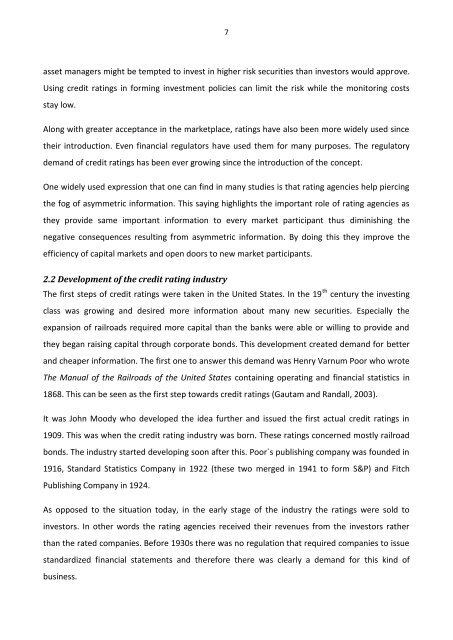Do Credit Rating Announcements Have Informational Value ...
Do Credit Rating Announcements Have Informational Value ...
Do Credit Rating Announcements Have Informational Value ...
You also want an ePaper? Increase the reach of your titles
YUMPU automatically turns print PDFs into web optimized ePapers that Google loves.
7<br />
asset managers might be tempted to invest in higher risk securities than investors would approve.<br />
Using credit ratings in forming investment policies can limit the risk while the monitoring costs<br />
stay low.<br />
Along with greater acceptance in the marketplace, ratings have also been more widely used since<br />
their introduction. Even financial regulators have used them for many purposes. The regulatory<br />
demand of credit ratings has been ever growing since the introduction of the concept.<br />
One widely used expression that one can find in many studies is that rating agencies help piercing<br />
the fog of asymmetric information. This saying highlights the important role of rating agencies as<br />
they provide same important information to every market participant thus diminishing the<br />
negative consequences resulting from asymmetric information. By doing this they improve the<br />
efficiency of capital markets and open doors to new market participants.<br />
2.2 Development of the credit rating industry<br />
The first steps of credit ratings were taken in the United States. In the 19 th century the investing<br />
class was growing and desired more information about many new securities. Especially the<br />
expansion of railroads required more capital than the banks were able or willing to provide and<br />
they began raising capital through corporate bonds. This development created demand for better<br />
and cheaper information. The first one to answer this demand was Henry Varnum Poor who wrote<br />
The Manual of the Railroads of the United States containing operating and financial statistics in<br />
1868. This can be seen as the first step towards credit ratings (Gautam and Randall, 2003).<br />
It was John Moody who developed the idea further and issued the first actual credit ratings in<br />
1909. This was when the credit rating industry was born. These ratings concerned mostly railroad<br />
bonds. The industry started developing soon after this. Poor´s publishing company was founded in<br />
1916, Standard Statistics Company in 1922 (these two merged in 1941 to form S&P) and Fitch<br />
Publishing Company in 1924.<br />
As opposed to the situation today, in the early stage of the industry the ratings were sold to<br />
investors. In other words the rating agencies received their revenues from the investors rather<br />
than the rated companies. Before 1930s there was no regulation that required companies to issue<br />
standardized financial statements and therefore there was clearly a demand for this kind of<br />
business.















